Fiber-Coupled Laser Sources: Visible
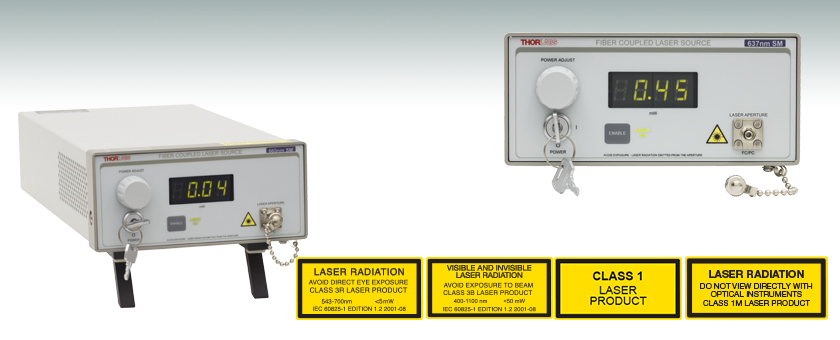
- SM, MM, and PM Sources Available
- Full Output Powers from 2.5 to 50.0 mW
- Stable, Low Noise, Constant Power Operation
S1FC660
660 nm, 15.0 mW
Front Panel Display Provides an Enable Button, Laser Power Control, and Display Screen

Please Wait
| Single Channel Benchtop Laser Sources Selection Guide | |||||
|---|---|---|---|---|---|
| Spectrum | Wavelength | TEC | Laser Type | Cavity Type | Output Fiber Type |
| Visible | 405 - 675 nm | No | Semiconductor | Fabry Perot | SM, MM, or PM |
| 405 - 685 nm | Yes | Semiconductor | Fabry Perot | SM | |
| NIR | 785 - 1550 nm | No | Semiconductor | Fabry Perot | SM or PM |
| 705 - 2000 nm | Yes | Semiconductor | Fabry Perot | SM | |
| 1310 - 1550 nm | Yes | Semiconductor | DFB | SM | |
| 1900 - 2000 nm | N/A | Fiber Laser | Fabry Perot | SM | |
| MIR | 2.7 µm | N/A | Fiber Laser | Fabry Perot | SM |
| Other Fiber-Coupled Laser Sources | |||||
Features
- Available Wavelengths:
- SM: 405 to 675 nm
- MM: 473 nm
- PM: 635 nm
- Single Mode or Multimode FC/PC Fiber Interface
- Power Level is Adjustable via Knob and BNC Modulation Input
- Stable, Low Noise, Constant Power Operation
- Interlock Circuit Provided via 2.5 mm Mono Jack
Thorlabs offers single mode, multimode, and polarization-maintaining fiber-coupled laser sources in the visible spectrum. Each benchtop laser source features both a pigtailed Fabry-Perot laser diode and current controller in a single unit.
The front panel of each laser source displays the output power in mW, an on/off key, and an enable button, and a knob to adjust the laser power. The back panel includes a BNC input that allows the laser diode drive current to be controlled via an external DC or sine wave voltage source and a remote interlock input.
Please refer to the table to the right for all of our single channel benchtop laser sources.
| Single Mode Source Specifications | |||||||
|---|---|---|---|---|---|---|---|
| Item # | S1FC405 | S1FC635 | S1FC637 | S1FC660 | S1FC675 | ||
| Wavelength | Minimum | 395 nm | 625 nm | 630 nm | 645 nm | 660 nm | |
| Typical | 405 nm | 635 nm | 637 nm | 660 nm | 675 nm | ||
| Maximum | 415 nm | 640 nm | 645 nm | 665 nm | 680 nm | ||
| Spectruma | |||||||
| Minimum Full Output Power | 8.0 mW | 2.5 mW | 8.0 mW | 15.0 mW | 2.5 mW | ||
| Setpoint Resolution | 0.01 mW | 0.01 mW | 0.01 mW | 0.01 mW | 0.01 mW | ||
| Laser Class | 3B | 3R | 3B | 3B | 3R | ||
| Fiber | |||||||
| Fiber Type | S405-XP | SM600 | SM600 | SM600 | SM600 | ||
| Mode Field Diameterb | 3.3 µm @ 405 nm | 3.6 - 5.3 µm | 3.6 - 5.3 µm | 3.6 - 5.3 µm | 3.6 - 5.3 µm | ||
| Numerical Aperture | 0.12 | 0.10 - 0.14 | 0.10 - 0.14 | 0.10 - 0.14 | 0.10 - 0.14 | ||
| Output Fiber Connector | FC/PC, Wide 2.1 mm Key Compatible | ||||||
| Electrical | |||||||
| Power Stability | 15 min: ±0.05 dB, 24 hr: ±0.1 dB (After 1 hr Warm-Up at 25 ± 10 °C Ambient) |
||||||
| Display Accuracy | ±10% | ||||||
| Adjustment Range | ~0 mW to Full Power | ||||||
| Input Power | 115 VAC / 230 VAC (Switch Selectable) 50 - 60 Hz | ||||||
| Modulation Input | 0 - 5 V = 0 - Full Power, DC or Sine Wave Input Only | ||||||
| Modulation Bandwidth |
5 kHz Full Depth of Modulation 30 kHz Small Signal Modulation |
||||||
| Environmental | |||||||
| Operating Temperature | 15 to 35 °C | ||||||
| Storage Temperature | 0 to 50 °C | ||||||
| Multimode Source Specifications | |
|---|---|
| Item # | S1FC473MM |
| Wavelength | 473 nm |
| Maximum Output Powera | 50.0 mW |
| Stability | 15 min: ±0.05 dB, 24 hr: ±0.1 dB (After 1 hr Warm-Up at 25 ± 10 °C Ambient) |
| Display Accuracy | ±10 % |
| Setpoint Resolution | 0.1 mW |
| Adjustment Range | ~0 mW to Full Power |
| AC Input | 115 / 230 VAC (Switch Selectable) 50 - 60 Hz |
| Modulation Input | 0 - 5 V = 0 - Full Power, DC or Sine Wave Input Only |
| Modulation Bandwidth | 5 kHz Full Depth of Modulation 30 kHz Small Signal Modulation |
| Fiber | FG105UCA |
| Environmental | |
| Operating Temperature | 15 to 35 °C |
| Storage Temperature | 0 to 50 °C |
| Polarization-Maintaining Source Specifications | ||||
|---|---|---|---|---|
| Item # | S1FC635PM | |||
| Wavelengtha | 635 nm | |||
| Minimum Full Output Power | 2.5 mW | |||
| Stability | 15 min: ±0.05 dB, 24 hr:±0.1 dB (After 1 hr Warm-Up at 25 ± 10 °C Ambient) |
|||
| Display Accuracy | ±10% | |||
| Setpoint Resolution | 0.01 mW | |||
| Adjustment Range | ~0 mW to Full Power | |||
| Minimum Polarization Extinction Ratio | 15 dB | |||
| Environmental | ||||
| Operating Temperature | 15 to 35 °C | |||
| Storage Temperature | 0 to 50 °C | |||
| AC Input | 115 VAC / 230 VAC (Switch Selectable) 50 - 60 Hz | |||
| Modulation Input | 0 - 5 V = 0 - Full Power, DC or Sine Wave Input Only | |||
| Modulation Bandwidth | 5 kHz Full Depth of Modulation 30 kHz Small Signal Modulation |
|||
| Fiber | PM630-HP | |||
Modulation In
BNC Female
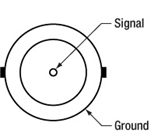
0 to 5 V Max, 50 Ω
Remote Interlock Input
2.5 mm Mono Jack
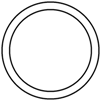
Terminals must be shorted either by included plug or user device, i.e. external switch, for laser mode "ON" to be enabled.
Laser Safety and Classification
Safe practices and proper usage of safety equipment should be taken into consideration when operating lasers. The eye is susceptible to injury, even from very low levels of laser light. Thorlabs offers a range of laser safety accessories that can be used to reduce the risk of accidents or injuries. Laser emission in the visible and near infrared spectral ranges has the greatest potential for retinal injury, as the cornea and lens are transparent to those wavelengths, and the lens can focus the laser energy onto the retina.
Safe Practices and Light Safety Accessories
- Laser safety eyewear must be worn whenever working with Class 3 or 4 lasers.
- Regardless of laser class, Thorlabs recommends the use of laser safety eyewear whenever working with laser beams with non-negligible powers, since metallic tools such as screwdrivers can accidentally redirect a beam.
- Laser goggles designed for specific wavelengths should be clearly available near laser setups to protect the wearer from unintentional laser reflections.
- Goggles are marked with the wavelength range over which protection is afforded and the minimum optical density within that range.
- Laser Safety Curtains and Laser Safety Fabric shield other parts of the lab from high energy lasers.
- Blackout Materials can prevent direct or reflected light from leaving the experimental setup area.
- Thorlabs' Enclosure Systems can be used to contain optical setups to isolate or minimize laser hazards.
- A fiber-pigtailed laser should always be turned off before connecting it to or disconnecting it from another fiber, especially when the laser is at power levels above 10 mW.
- All beams should be terminated at the edge of the table, and laboratory doors should be closed whenever a laser is in use.
- Do not place laser beams at eye level.
- Carry out experiments on an optical table such that all laser beams travel horizontally.
- Remove unnecessary reflective items such as reflective jewelry (e.g., rings, watches, etc.) while working near the beam path.
- Be aware that lenses and other optical devices may reflect a portion of the incident beam from the front or rear surface.
- Operate a laser at the minimum power necessary for any operation.
- If possible, reduce the output power of a laser during alignment procedures.
- Use beam shutters and filters to reduce the beam power.
- Post appropriate warning signs or labels near laser setups or rooms.
- Use a laser sign with a lightbox if operating Class 3R or 4 lasers (i.e., lasers requiring the use of a safety interlock).
- Do not use Laser Viewing Cards in place of a proper Beam Trap.
Laser Classification
Lasers are categorized into different classes according to their ability to cause eye and other damage. The International Electrotechnical Commission (IEC) is a global organization that prepares and publishes international standards for all electrical, electronic, and related technologies. The IEC document 60825-1 outlines the safety of laser products. A description of each class of laser is given below:
| Class | Description | Warning Label |
|---|---|---|
| 1 | This class of laser is safe under all conditions of normal use, including use with optical instruments for intrabeam viewing. Lasers in this class do not emit radiation at levels that may cause injury during normal operation, and therefore the maximum permissible exposure (MPE) cannot be exceeded. Class 1 lasers can also include enclosed, high-power lasers where exposure to the radiation is not possible without opening or shutting down the laser. |  |
| 1M | Class 1M lasers are safe except when used in conjunction with optical components such as telescopes and microscopes. Lasers belonging to this class emit large-diameter or divergent beams, and the MPE cannot normally be exceeded unless focusing or imaging optics are used to narrow the beam. However, if the beam is refocused, the hazard may be increased and the class may be changed accordingly. |  |
| 2 | Class 2 lasers, which are limited to 1 mW of visible continuous-wave radiation, are safe because the blink reflex will limit the exposure in the eye to 0.25 seconds. This category only applies to visible radiation (400 - 700 nm). |  |
| 2M | Because of the blink reflex, this class of laser is classified as safe as long as the beam is not viewed through optical instruments. This laser class also applies to larger-diameter or diverging laser beams. |  |
| 3R | Class 3R lasers produce visible and invisible light that is hazardous under direct and specular-reflection viewing conditions. Eye injuries may occur if you directly view the beam, especially when using optical instruments. Lasers in this class are considered safe as long as they are handled with restricted beam viewing. The MPE can be exceeded with this class of laser; however, this presents a low risk level to injury. Visible, continuous-wave lasers in this class are limited to 5 mW of output power. |  |
| 3B | Class 3B lasers are hazardous to the eye if exposed directly. Diffuse reflections are usually not harmful, but may be when using higher-power Class 3B lasers. Safe handling of devices in this class includes wearing protective eyewear where direct viewing of the laser beam may occur. Lasers of this class must be equipped with a key switch and a safety interlock; moreover, laser safety signs should be used, such that the laser cannot be used without the safety light turning on. Laser products with power output near the upper range of Class 3B may also cause skin burns. |  |
| 4 | This class of laser may cause damage to the skin, and also to the eye, even from the viewing of diffuse reflections. These hazards may also apply to indirect or non-specular reflections of the beam, even from apparently matte surfaces. Great care must be taken when handling these lasers. They also represent a fire risk, because they may ignite combustible material. Class 4 lasers must be equipped with a key switch and a safety interlock. |  |
| All class 2 lasers (and higher) must display, in addition to the corresponding sign above, this triangular warning sign. |  |
|
| Posted Comments: | |
user
(posted 2024-01-23 11:27:40.983) Which is the maximum output power of the model S1FC405? ksosnowski
(posted 2024-01-23 11:50:22.0) Hello, thanks for reaching out to Thorlabs. Each unit is calibrated to achieve the maximum power for the particular laser diode used in the device. Due to variations in the coupling process, no two units will have the same exact maximum power. For S1FC405, we guarantee at least 8.0 mW on each unit we build. Ensuring that the patch cables used are always cleaned is an important measure to maintaining the output over the life of the laser, as any debris can cause backreflections which may damage the laser inside and cause reduced power. I have reached out directly to discuss this in further detail. Nazim Bharmal
(posted 2023-07-14 08:04:48.137) In your manual, there is no information regarding the modulation input connector type. That is only on the webpage (in small font) and via the 'Pin Diagrams' tab (arguably hidden). So I'd suggest modifying the manual to include the specification. cdolbashian
(posted 2023-07-21 11:50:13.0) Thank you for reaching out to us with this feedback. Within the manual, under the "Modulating the Laser Output" section (5.5), the first bullet point describes the required electrical connection. Regarding the hidden pin diagrams tab, we include such a tab on all pages which have devices with electrical outputs so that the information is visible and easily accessible without having to find it within a manual (in which it is also included). I have reached out to you directly to clarify this further. Tatsuo Yamaguchi
(posted 2023-07-05 13:26:23.857) お世話になっております。
御社のファイバレーザー光源S1FC660を購入したものです。
こちらの光源の光量のツマミを回したときの光量の安定するまでの時間についての仕様などはございますでしょうか?
感覚的な記述で恐縮なのですが、1mW→3mWまで光量を上げると、一度4mW程度まで上がりそのあと3mWまで下がるのに10-20秒程度かかっているという印象です。
よろしくお願いいたします。 cdolbashian
(posted 2023-07-14 04:11:48.0) Thank you for reaching out to us with this inquiry. A tech support agent has contacted your from our local office. user
(posted 2021-04-23 01:45:27.227) In my optical system,maybe about 20% laser power will back reflection into laser source.I am worried about back reflection light will damage laser source.Does this laser source include isolator?Thank you. YLohia
(posted 2021-04-23 11:35:06.0) Thank you for contacting Thorlabs. Unfortunately, such a high back reflection will damage the source since this doesn't come with an integrated isolator. That being said, a custom fiber based isolator for 635 nm can be ordered using the form on this page (https://www.thorlabs.com/newgrouppage9.cfm?objectgroup_id=3260) and be used right on the output to reduce the amount of backreflections going into the laser cavity. user
(posted 2019-05-21 14:13:05.223) In the product description you state
"... All of our fiber-pigtailed lasers utilize an angled fiber ferrule at the internal laser/fiber launch point to minimize reflections back into the laser diode, thereby increasing the stability of the laser diode's output."
And yet the specifications call out an FC/PC and not an FC/APC. I am confused. Can you please clarify? YLohia
(posted 2019-05-21 03:00:34.0) Hello, thank you for your feedback and bringing this typo to our attention. The specs are correct -- the items on this page (as of 5/2019) are FC/PC and not FC/APC (APC connections can be quoted as custom items by emailing techsupport@thorlabs.com). I am working with our technical marketing team to get this resolved. Please accept our apologies for any confusion caused by this. Andrey Kuznetsov
(posted 2019-05-01 14:28:16.583) NOTICE to Customers: I compared 630HP and SM600 fibers when connected to these Fiber sources. These sources have an internal SM600 fiber from the diode to the front bulkhead connector. Thorlabs rightly says to use cables of the same type, however even though 630HP and SM600 share almost exactly the same parameters like NA, etc, based on my tests: 630HP insertion can cause output attenuation up to 95%, while SM600 fiber attenuation was only up to 20%. The issue I had was that when inserting a fiber into the bulkhead, with the key polarizer aligned, rotating and tightening the connector would result in an unpredictable attenuation of light output as measured with a photodiode. We're now switching to SM600 fibers to avoid severe attenuation losses due to fiber coupling issues. Thorlabs should explicitly state this on the Overview page in bold letters that customers must use SM600 fiber to avoid huge attenuation losses due to coupling. mmcclure
(posted 2019-05-02 10:52:01.0) Hello, thank you for your feedback. Yes, for our single mode fiber-coupled laser sources, we recommend using a single mode patch cable that is the same fiber type as the fiber-pigtailed laser inside the device. We will make this recommendation more explicit on the webpage. akuznetsov
(posted 2018-09-27 19:42:45.16) What is the fiber core size inside these laser bench sources?
What core size fiber patch cable should I use to optimize light throughput? YLohia
(posted 2018-09-28 11:33:03.0) Hello, the fiber types used are listed in the Specs tab: https://www.thorlabs.com/newgrouppage9.cfm?objectgroup_id=1500&tabname=Specs along with the MFD and NA. In order to maximize coupling efficiency, you should use the same fiber or a multimode fiber with a larger MFD and NA than the one used in the benchtop unit. akuznetsov
(posted 2018-09-27 17:33:36.43) We have a S1FC637 and we see that 637*2=1274nm wavelength is also present on the output, is this normal? Shouldn't there be a filter in the unit to prevent the doublet from outputting?
We are using the 637nm to excite emission in the NIR so the 1274nm output from the laser is interfering with out results. YLohia
(posted 2018-10-03 03:02:17.0) Hello, thank you for contacting Thorlabs. This is certainly not normal and not expected of a GaAs-based chip. I took a few scans of the S1FC637 with our OSA207C optical spectrum analyzer and did not find any significant emission around 1274nm (at max output power setting). Based on our correspondence, the issue was being caused by the small fraction of the stimulus light (1274nm) being fed into the spectrometer since the stimulus and collection path were the same. melanie
(posted 2018-09-04 08:20:38.627) 1.What is the laser threshold power for S1FC635PM ?
2.Would you consider making a PM fibre-coupled green laser ? nbayconich
(posted 2018-09-25 10:17:46.0) Thank you for contacting Thorlabs. We do not specify a threshold power for the S1FC635PM benchtop source however the setpoint resolution is 0.01mW and can be adjusted from 0 - 2.5mW. The threshold current for the diode is about 50mA and the minimum range is set to just below the lasing threshold. The output is mostly off but there will be a very small amount of light still present since a small amount of light is needed for the power control circuit to be active.
I will reach out to you directly to discuss our custom capabilities. melanie
(posted 2017-03-23 13:05:57.74) I have 2 questions:
1) If connected to one of your PM patchcords, what will be the typical polarisation extinction when the light emerges from the patchcord ?
2) If we turn the laser right down, will it become incoherent ? (this is useful to us)
Thanks,
Melanie tfrisch
(posted 2017-03-30 01:17:52.0) Hello Melanie, thank you for contacting Thorlabs. When used with a PM patch cable, S1FC635PM has an extinction ratio of >20dB. As for the laser power, this unit is not intended for operation below the threshold current of the diode. I will reach out to you directly to discuss your application. acable
(posted 2008-08-15 10:52:31.0) Related Products… please think about the related products that are most often used with the product that is being featured. In the case of the fiber coupled laser sources it would probably be: patch cable, collimation package, and perhaps a mirror mount and adapter to hold and aim the collimated light field.
I would even think about adding a little text by each price box with a labeled photo of the parts all connected together, with a kit being offered for each of the wavelengths. I would then use the Related Products links (and refer to them in the text) to allow the customer to put together their own parts list (longer cables, different collimation packages, different mounts). |

- Five Wavelengths Available from 405 to 675 nm
- Single Mode, FC/PC Fiber Interface
- Minimum Full Output Powers of Up to 15.0 mW
- Fiber Patch Cables Sold Separately
- Custom Wavelengths Available; Contact Tech Support
These Single Mode Fiber-Coupled Laser Sources conveniently package a pigtailed Fabry-Perot laser diode and current controller into a single benchtop unit. The Fabry-Perot laser diode inside each unit is pigtailed to a single mode fiber that is terminated at an FC/PC bulkhead (wide and narrow key compatible) attached to the front panel of the unit. Thorlabs offers single mode fiber optic patch cables for connecting to the bulkhead on the front panel. To minimize losses, we recommend using a fiber patch cable that is the same fiber type as the fiber-pigtailed laser; refer to the Specs tab for the internal fiber type used for the pigtail. Additionally, to reduce noise from back reflections, we recommend that a hybrid FC/PC to FC/APC cable be used with the FC/PC end connected to the laser source.
Also found on the front panel is a display that shows the output power in mW, an on/off key, an enable button, and a knob to adjust the laser power. The back panel includes an input that allows the laser diode drive current to be controlled via an external DC or sine wave voltage source and a remote interlock input.
Note: The laser must be off when connecting or disconnecting fibers from the device, particularly for power levels above 10 mW.
For applications using a 635 nm source, Thorlabs also offers a compact fiber-coupled laser source with a USB interface. For optogenetics applications, Thorlabs offers a 473 nm benchtop laser source below that incorporates multimode fiber. For a polarized output, laser sources that incorporate polarization-maintaining fiber are also available below. For telecom applications that require tunable output, please see our benchtop tunable telecom laser sources. For laser sources with custom wavelengths or with an FC/APC fiber interface, please contact Tech Support.

- Output Wavelength: 473 nm
- Multimode FC/PC Fiber Interface
- 50.0 mW Power Output
- Fiber Patch Cables Sold Separately
The S1FC473MM Fiber-Coupled Laser provides 50.0 mW of output power and a wavelength of 473 nm, making it an ideal source for many Optogenetics applications. It includes a pigtailed FP laser diode and current controller in a single benchtop unit. The unit's output can also be externally modulated at 5 kHz full depth/30 kHz small signal. The output is a FG105UCA multimode fiber terminated at an FC/PC connector. The unit is compatible with our extensive line of multimode patch cables and optogenetics equipment.
The front panel includes a display that shows the output power in mW, an on/off key, an enable button, and a knob to adjust the laser power. The back panel includes an input that allows the laser diode drive current to be controlled via an external voltage source and a remote interlock input. For complete operating instructions, please refer to the manual, available by clicking the red Docs icon (![]() ) below.
) below.
Note: The laser must be off when connecting or disconnecting fibers from the device, particularly for power levels above 10 mW.
We also offer fiber-coupled LEDs as well as other fiber-coupled laser sources.

- Output Wavelength: 635 nm
- Single Mode Polarization-Maintaining FC/PC Fiber Interface
- Minimum Full Output Power of 2.5 mW
- Fiber Patch Cables Sold Separately
- Slow Axis of the PM Fiber Aligned to the Narrow Key of the FC/PC Bulkhead Connector
- Custom Visible Wavelengths Available; Contact Tech Support
These Polarization-Maintaining Fiber-Coupled Laser Sources package a pigtailed Fabry-Perot laser diode inside each benchtop unit. The laser diode is pigtailed to a single mode PM fiber that is terminated at an FC/PC bulkhead attached to the front panel of the unit. During the pigtailing process, the fiber alignment is actively maintained so that the polarization axis of the laser diode is aligned with the slow-axis of the PM fiber. In addition, the slow-axis of the PM fiber is aligned to the narrow key of the FC/PC bulkhead connector on the front panel of the benchtop unit. Thorlabs offers polarization-maintaining fiber optic patch cables for connecting to the bulkhead on the front panel. To minimize losses, we recommend using a fiber patch cable that is the same fiber type as the fiber-pigtailed laser; refer to the Specs tab for the internal fiber type used for the pigtail. Additionally, to reduce noise from back reflections, we recommend that a hybrid FC/PC to FC/APC cable be used with the FC/PC end connected to the laser source.
Also found on the front panel is a display that shows the output power in mW, an on / off key, an enable button, and a knob to adjust the laser power. The back panel includes an input that allows the laser diode drive current to be controlled via an external voltage source and a remote interlock input.
Note: The laser must be off when connecting or disconnecting fibers from the device.
 Products Home
Products Home



















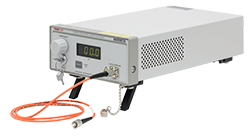
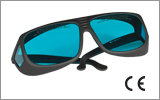
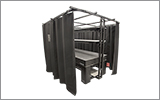
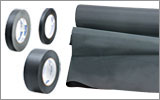
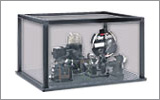
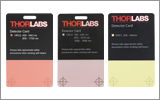
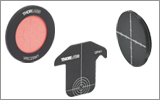
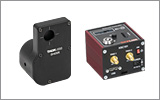
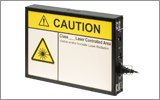
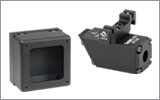
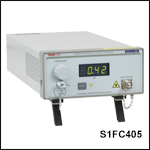
 Zoom
Zoom
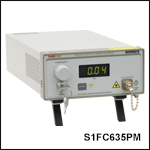
 Fabry-Perot Laser Sources
Fabry-Perot Laser Sources